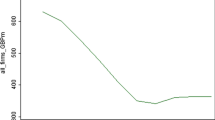Abstract
A dynamic framework based on the process of firm selection and industry evolution is used to analyse the post-entry performance of new firms. In particular, it is hypothesized that, based on the stylized fact that virtually all new firms start at a very small scale of output, firm growth and survival are shaped by the need to attain an efficient level of output. The post-entry performance of more than 11,000 U.S. manufacturing firms established in 1976 is tracked throughout the subsequent tenyear period. Firm growth is found to be negatively influenced by firm size but positively related to the extent of scale economies, capital intensity, innovative activity, and market growth. By contrast, the likelihood of survival is identified as being positively influenced by firm size, market growth, and capital intensity, but negatively affected by the degree of scale economies in the industry. When viewed through the dynamic framework of firm selection and industry evolution, the empirical results shed considerable light on several paradoxes in the industrial organization literature, such as the continued persistence over time of an asymmetrical firm-size distribution consisting predominantely of suboptimal scale firms, and the failure of capital intensity and scale economies to substantially deter the entry and start-up of new firms.
Similar content being viewed by others
References
Acs ZJ, Audretsch DB (1990) Innovation and Small Firms. MIT Press, Cambridge, Mass
Acs ZJ, Audretsch DB (1989) Small-Firm Entry in U.S. Manufacturing. Economica 56: 255–265
Acs ZJ, Audretsch DB (1988) Innovation in Large and Small Firms: An Empirical Analysis. Am Econ Rev 78: 678–690
Acs ZJ, Audretsch DB (1987) Innovation, Market Structure and Firm Size. Rev Econ Statistics 69: 567–575
Acs ZJ, Audretsch DB, Feldman MP (1992) Real Effects of Academic Research: Comment. Am Econ Rev 82: 363–367
Albach H, Bock K, Warnke T (1984) Wachstumskrisen von Unternehmen. Schmalenbachs Z Betriebswirtsch Forschung 36: 779–793
Armington C, Odle M (1982) Small Business—How Many Jobs? Brookings Rev 1: 14–17
Audretsch DB (in press) Innovation and Industry Evolution. MIT Press, Cambridge, Mass
Audretsch DB (1991) New-Firm Survival and the Technological Regime. Rev Econ Statistics 60: 441–450
Austin JS, Rosenbaum DI (1990) The Determinants of Entry and Exit Rates Into U.S. Manufacturing Industries. Rev Industrial Organization 5: 211–223
Baldwin JR, Gorecki PK (1991) Entry, Exit and Productivity Growth. In: Geroski P, Schwalbach J (eds) Entry and Market Contestability: An International Comparison. Basil Blackwell, Oxford, pp 244–256
Boden R, Phillips BD (1985) Uses and Limitations of USEEM/USELM Data. Office of Advocacy, U.S. Small Business Administration, Washington DC, November
Brown HS, Phillips BD (1989) Comparison Between Small Business Data Base (USEEM) and Bureau of Labor Statistics (BLS) Employment Data: 1978–1986. Small Business Econ 1: 273–284
Cable J, Schwalbach J (1991) International Comparisons of Entry and Exit. In: Geroski P, Schwalbach J (eds) Entry and Market Contestability: An International Comparison. Basil Blackwell, Oxford, pp 257–281
Caves RE, Porter ME (1976) Barriers to Exit. In: Masson RT, Qualls PD (eds) Essays on Industrial Organization in Honor of Joe S. Brain. Ballinger, Cambridge, Mass, pp 39–69
Caves RE, Khalilzadeh-Shirazi J, Porter ME (1975) Scale Economies in Statistical Analyses of Market Power. Rev Econ Statistics 57: 133–140
Comanor WS, Wilson TA (1967) Advertising, Market Structure, and Performance. Rev Econ Statistics 49: 423–440
Dunne T, Roberts MJ, Samuelson L (1988) Patterns of Firm Entry and Exit in U.S. Manufacturing Industries. Rand J Econ 19: 495–515
Dunne T, Roberts MJ, Samuelson L (1989) The Growth and Failure of U.S. Manufacturing Plants. Q J Econ 104: 671–698
Evans DS (1987a) The Relationship Between Firm Growth, Size and Age: Estimates for 100 Manufacturing Industries. J Industrial Econ 35: 567–581
Evans DS (1987b) Tests of Alternative Theories of Firm Growth. J Political Econ 95: 657–674
Evans LB, Siegfried JJ (1992) Entry and Exit in United States Manufacturing Industries from 1977 to 1982. In: Andretsch DB, Siegfried JJ (eds) Empirical Studies in Industrial Organization: Essays in Honor of Leonard W. Weiss. Kluwer, Boston
Geroski P, Schwalbach J (eds) (1991) Entry and Market Contestability: An International Comparison. Basil Blackwell, Oxford
Gort M, Klepper S (1982) Time Paths in the Diffusion of Product Innovations. Econ J 92: 630–653
Hart PE, Prais SJ (1956) The Analysis of Business Concentration: A Statistical Approach. J Royal Statistical Society 119 (Part 2): 150–191
Jovanovic B (1982) Selection and Evolution of Industry. Econometrica 50: 649–760
Mahmood T (1992) Does the Hazard Rate of New Plants Vary Between High-and Low-Tech Industries? Small Business Econ 4: 72–84
Mansfield E (1962) Entry, Gibrat's Law, Innovation, and the Growth of Firms. Am Econ Rev 52: 1023–1051
Pakes A, Ericson R (1987) Empirical Implications of Alternative Models on Firm Dynamics. Department of Economics, University of Wisconsin-Madison
Phillips BD, Kirchhoff BA (1989) Formation Growth and Survival: Small Firm Dynamics in the U.S. Economy. Small Business Econ 1: 65–74
Pratten CF (1971) Economies of Scale in Manufacturing Industry. Cambridge University Press, Cambridge
Ross DR, Bradburd RM (1988) A General Measure of Multidimensional Inequality. Oxford Bull Econ Statistics 50: 429–433
Scherer FM (1973) The Determinants of Industry Plant Sizes in Six Nations. Rev Econ Statistics 55: 135–145
Scherer FM, Ross D (1990) Industrial Market Structure and Economic Performance, 3rd ed. Houghton Mifflin, Boston
Simon HA, Bonini CP (1958) The Size Distribution of Business Firms, Am Econ Rev 48: 607–617
U.S. Small Business Administration, Office of Advocacy (1987) Linked 1976–1984 USEEM User's Guide. Washington DC, July
Weiss LW (1991) In: Audretsch DB, Yamawaki H (eds) Structure, Conduct, and Performance. New York University Press, New York
Weiss LW (1976) Optimal Plant Scale and the Extent of Suboptimal Capacity. In: Masson RT, Qualls PD (eds) Essays on Industrial Organization in Honor of Joe S. Bain. Ballinger, Cambridge, Mass, pp 126–134
Weiss LW (1964) The Survival Technique and the Extent of Suboptimal Capacity. J Political Econ 72: 246–261
Author information
Authors and Affiliations
Rights and permissions
About this article
Cite this article
Audretsch, D.B., Mahmood, T. Firm selection and industry evolution: the post-entry performance of new firms. J Evol Econ 4, 243–260 (1994). https://doi.org/10.1007/BF01236371
Issue Date:
DOI: https://doi.org/10.1007/BF01236371




